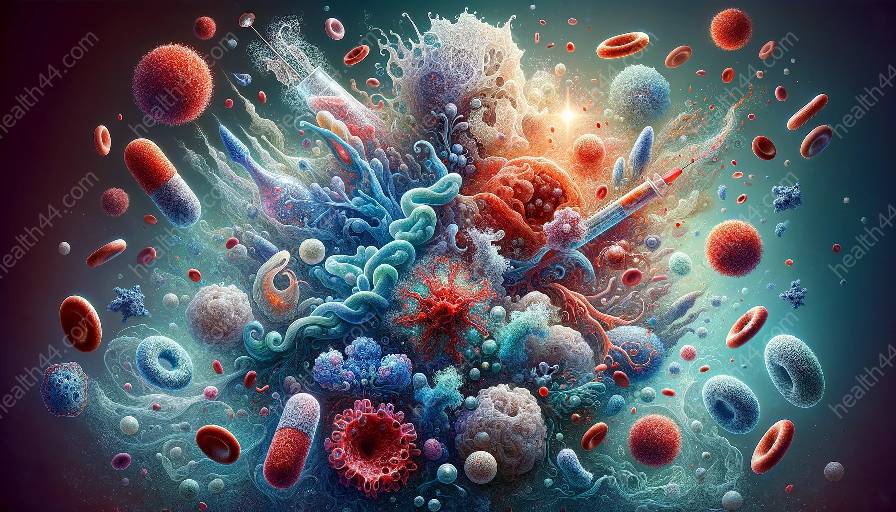Hypersensitivity reactions, also known as allergic reactions, refer to undesirable immune responses against harmless environmental substances. These reactions are categorized into four types based on their underlying mechanisms, each with distinct immunopathological features. Understanding these hypersensitivity reactions is essential in comprehending the complexities of immunology and immunopathology.
Type I Hypersensitivity Reaction
Type I hypersensitivity reactions are immediate, IgE-mediated responses to allergens. When an individual with a predisposition to allergies encounters an allergen, such as pollen or pet dander, their immune system produces excessive amounts of IgE antibodies. These antibodies bind to Fc𝜖RI receptors on mast cells and basophils, sensitizing them to subsequent exposure to the allergen.
Upon re-exposure to the same allergen, cross-linking of IgE molecules on the sensitized cells occurs, leading to the release of inflammatory mediators such as histamine, leukotrienes, and prostaglandins. This cascade of events results in the characteristic symptoms of immediate hypersensitivity, including itching, hives, rhinitis, and, in severe cases, anaphylaxis.
Mechanism
The underlying mechanism of type I hypersensitivity involves the activation of mast cells and basophils by allergen-induced cross-linking of IgE, leading to the release of pro-inflammatory mediators and subsequent allergic symptoms.
Type II Hypersensitivity Reaction
Type II hypersensitivity reactions, also known as cytotoxic hypersensitivity, involve the destruction of host cells or tissues by antibodies. This process occurs when antibodies, typically IgM or IgG, bind to antigens expressed on the surface of host cells.
Subsequent activation of the complement system or antibody-dependent cellular cytotoxicity (ADCC) leads to the lysis of the affected cells. Type II hypersensitivity plays a crucial role in autoimmune diseases such as autoimmune hemolytic anemia and Graves' disease, as well as in transfusion reactions and hemolytic disease of the newborn.
Mechanism
The mechanism of type II hypersensitivity involves antibody-mediated destruction of host cells through complement activation or ADCC, leading to tissue damage and clinical manifestations of the associated diseases.
Type III Hypersensitivity Reaction
Type III hypersensitivity reactions, also known as immune complex-mediated hypersensitivity, arise from the formation of immune complexes consisting of antigens and antibodies. These complexes deposit in various tissues, triggering an inflammatory response mediated by complement activation and the recruitment of neutrophils and other inflammatory cells.
Consequently, tissue damage occurs due to the release of toxic mediators and enzymes by the infiltrating cells, leading to conditions such as systemic lupus erythematosus, rheumatoid arthritis, and serum sickness.
Mechanism
The mechanism of type III hypersensitivity involves the deposition of immune complexes in tissues, leading to complement activation and the recruitment of inflammatory cells, ultimately resulting in tissue damage and the clinical features observed in associated diseases.
Type IV Hypersensitivity Reaction
Type IV hypersensitivity reactions, also known as delayed-type hypersensitivity, are T cell-mediated reactions that exhibit a delayed onset, typically 24-72 hours after antigen exposure. These reactions involve the activation of effector T cells, particularly CD4+ T cells (Th1 cells) and CD8+ cytotoxic T cells, which recognize antigens presented by antigen-presenting cells.
The release of pro-inflammatory cytokines and the recruitment of mononuclear cells, particularly macrophages, to the site of antigen exposure lead to tissue damage and inflammation. Type IV hypersensitivity is implicated in various conditions, including contact dermatitis, tuberculin skin test reactions, and autoimmune diseases such as multiple sclerosis and type I diabetes.
Mechanism
The mechanism of type IV hypersensitivity involves the activation of T cells by antigens, leading to the release of cytokines and the recruitment of mononuclear cells, resulting in tissue damage and the clinical manifestations observed in delayed-type hypersensitivity reactions.
Immunopathological Considerations
The understanding of hypersensitivity reactions from an immunopathological perspective is crucial in delineating the underlying mechanisms and pathological changes associated with these responses. Immunopathology focuses on the study of immune-mediated diseases and the alterations in immune function that contribute to pathological conditions.
Excessive or dysregulated immune responses, such as those observed in hypersensitivity reactions, can lead to tissue damage, inflammation, and the manifestation of clinical symptoms. By elucidating the immunopathological aspects of hypersensitivity reactions, researchers and healthcare professionals can develop targeted interventions and therapeutic strategies to mitigate the adverse effects of these immune responses.
Immunological Implications
From an immunological standpoint, hypersensitivity reactions underscore the intricacies of immune system function and regulation. The four types of hypersensitivity reactions demonstrate different immunological mechanisms involving antibodies, immune complexes, and T cells, highlighting the diverse ways in which the immune system can respond to antigens.
Understanding the immunological basis of hypersensitivity reactions provides valuable insights into the interplay between the innate and adaptive immune systems, the mechanisms of immune recognition and memory, and the factors contributing to immune tolerance and dysregulation. This knowledge is instrumental in advancing immunological research and the development of immunotherapeutic approaches for allergic and autoimmune conditions.
Conclusion
Hypersensitivity reactions encompass a spectrum of immune-mediated responses that involve intricate immunopathological and immunological mechanisms. By categorizing these reactions into distinct types and elucidating their underlying processes, researchers and healthcare professionals can gain a comprehensive understanding of the complexities of immunopathology and immunology. This knowledge forms the foundation for devising targeted diagnostic and therapeutic strategies to address hypersensitivity-related disorders and enhance patient care.


